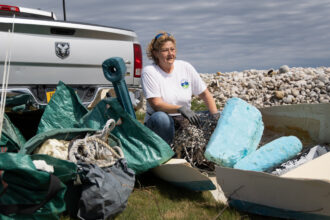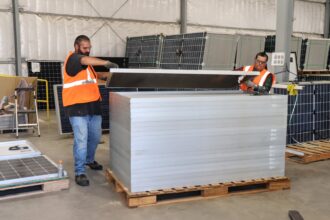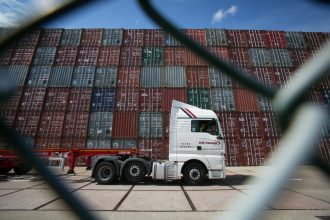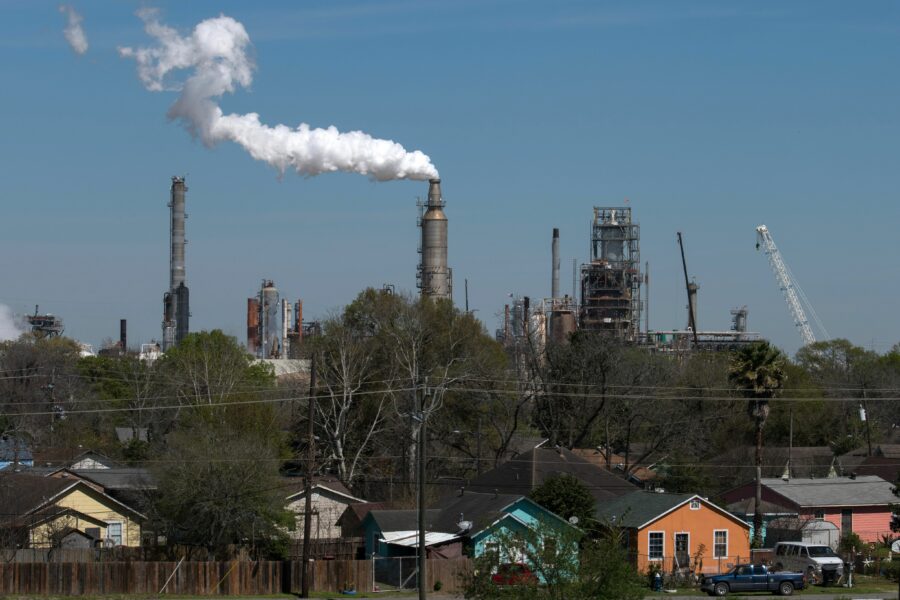Moving to New York can be a culture shock. When Liz French decamped from Indiana to Long Island City, Queens, in 1989—well before it was a trendy place to live—she was sad to learn she’d lost access to a beloved childhood ritual: composting. Her parents, “kind of hippies,” had introduced her to the practice growing up in Bloomfield, Indiana, but, in the Big Apple, there was no gardening “or any sort of composting,” she said. Back then Long Island City was, even for New York, very much an industrial environment.
Five years passed before French, now an editor for Library Journal, found a way to compost again. While visiting the Union Square Farmers Market, which was near where she worked at the time, French met a German woman, Christine Datz-Romero, a composting pioneer in the city. Datz-Romero ran a compost collection stand four times a week at Union Square, accepting New Yorkers’ food waste (sans meat and bones) and turning it into soil. Since French lived in Queens, the woman recommended she freeze her discards, and bring them to the drop-off station at the market whenever she could.
So she did. For almost a decade, French froze her scraps, rinds, grinds and peels, put them into a plastic bag or milk carton, tucked that into her backpack, and hopped on the train to work, stashing the cargo under her desk once she arrived. During her lunch breaks, French would drop the stuff at Union Square, then sit in the park and enjoy her lunch.
Gradually, composting caught on in New York, and French could travel to drop-offs a little closer to home, which, most recently, was a collection station run by GrowNYC in Ridgewood, Queens.
Then, last October, New York City made it so that practically all French had to do to discard her food waste was chuck it outside her front door. The Adams Administration rolled out what it has since called a voluntary “curbside composting program” across all of Queens, giving residents the option to set a bin of organic waste on the sidewalk for the Department of Sanitation (DSNY) to collect on designated recycling nights.
“I was overjoyed,” French said. The program was convenient for her, and she considered it a sign that the city was finally getting serious about composting—and she was right.

Earlier this year, Mayor Eric Adams announced the extension of the voluntary program to all five boroughs by 2024, touting it as the largest composting program in the country, beginning in all of Brooklyn on Monday. And, this summer, City Council passed a law that will require all New Yorkers to separate their organics from the rest of their trash—much like they already do for recycling. If all goes according to schedule, every household in New York will be diverting food from a landfill by the spring of 2025.
But most of the food scraps collected in Queens, and all of the food waste in Brooklyn, are unlikely to ever be used as compost to enrich soil by increasing nutrient retention and delivering nitrogen, phosphorus and potassium to plants.
Instead, New Yorkers’ food scraps will get turned into an “engineered bio-slurry” by WM, a multinational, multibillion-dollar private waste management company, and fed to microbes at a city wastewater treatment plant in Brooklyn, boosting the production of methane gas that National Grid can then use to help heat local homes and businesses.
The environmental implications of all this are murky, at best. On the one hand, the natural gas the food waste generates is un-fracked, freeing it from the greenhouse gas emissions and toxic waste associated with extracting oil and gas buried miles below the earth.
But, as composting advocates like Datz-Romero and Brooklynites who live near the wastewater treatment plant where the natural gas will be generated point out, this scraps-to-energy process is energy intensive, creates extensive truck traffic transporting the slurry and has the potential to leak methane, a climate super-pollutant. Methane has already been “flared” or burned off as part of the testing process, and creating gas to heat homes cuts against the city’s broader policy of moving away from gas heat and appliances toward renewables.
“I’m a little bit skeptical about the environmental benefits that are created through that,” said Datz-Romero, referring to “anaerobic digestion,” the process by which the microbes create natural gas. “Is that really the highest use we can think for our organics? I don’t think so.”
Solving the Garbage Problem
There is little consensus about how to handle food waste in the U.S., except that landfilling it should be avoided at all costs. Food rotting in landfills, crushed by the surrounding trash, suffocates, and decomposes without oxygen. In landfills without gas collection systems, this food, as it rots, emits methane, a potent greenhouse gas 80 times more potent at trapping heat in the earth’s atmosphere than CO2 over 20 years. Methane is the second most common human-produced greenhouse gas, accounting for 12 percent of the country’s emissions in 2021—nearly a fifth of which comes from landfills. The EPA estimates that each year, the U.S. sends 140 million acres’ worth of food to landfills, where it is the most common material among the heaps of discards.
New York City “rarely had a day in its history without a waste problem,” writes Martin V. Melosi in his book “Fresh Kills: A History of Consuming and Discarding in New York City.” Across two centuries, the city tried dumping refuse in its surrounding waterways, incinerating heaps of trash and building landfills to try and solve the garbage problem, but nothing stuck.
In 1997, the Bronx became the first of the five boroughs to try to solve the problem by shipping its residential waste outside city limits. WM won the bidding war for a three-year contract to transport Bronx refuse to a landfill in Waverly, Virginia. The city paid the company $51.72 for every ton of waste it shipped, in line with what it had cost the city to send scraps to its own Fresh Kills landfill on Staten Island.
The cost-effectiveness of the public-private partnership didn’t last; exporting waste ended up costing taxpayers $90 million more than the Giuliani administration had promised ($323 million a year). In 2017, New York City finalized a 20-year, $3.3 billion contract with WM to export waste from the Hamilton Avenue and Southwest Brooklyn marine transfer stations, the final contract from the Giuliani-era waste export deals.
In the last decade, New York has invested in keeping food out of landfills by trying to capture the energy stored in its discarded organics, and turn them into natural gas. In 2014, WM resubmitted an engineering report in support of a permit modification to their Varick Avenue transfer station, located about two miles from the city’s largest wastewater treatment facility. They wanted to add an organics processing facility. Their application was successful, and the company began sending slurry from its new facility down the road to the Newtown Creek wastewater treatment plant.
“Do You Smell Anything?”
On a mild morning this past winter, I arrived at WM’s organics processing facility in Elizabeth, New Jersey, to see how New York’s organic waste would be turned into slurry. (The facility on Varick Avenue in Brooklyn, which will actually handle food scraps from New York, does not host tours.) The building, a warehouse about the size of a football field, with sallow beige paneling, sat at the end of a row of residential homes five minutes from Newark Airport. At the other end of the street was a motel and a church.
Arielle Bernard, a WM sales support manager, and Nick Burreci, the facility manager, were the tour guides. We met in Burreci’s office, put on neon safety vests, hard hats and clear safety glasses, and Burreci gave a short safety lecture. He covered evacuation procedures in case of a fire, an explosion or an earthquake, none of which, I was assured, would happen that day. Then, Burreci led us out the door to the “tipping floor,” as it’s called, where all the rotten, old or unwanted food that local companies contract WM to handle gets dumped.
On the way, we passed a large cube with ducts running into the warehouse ahead of us. The din of the machine, which Burreci said traps smells from the hangar and is always on, sounded like airplanes landing at the nearby Newark airport.
“Do you smell anything?” Burreci asked me.
I inhaled, and said I did not.
“That means it’s working.”
As we headed towards the tipping hangar, Bernard explained that WM is part of New York’s plan to deal with the volume of food waste collected in its curbside program. “Be prepared for the smell,” she said, as we stepped through the door. Before us sprawled 15,625 square feet of space designed to handle 500 tons of food waste a day. It looked like it could fit about three small airplanes.
The place was a cesspool of rotten smells; so many different types of food make their way through here that it was difficult to identify a prevailing odor. Just then, an employee driving a forklift dumped the contents of a green plastic bin onto the floor near the hopper. The bin had come from a nearby church which had contracted with WM to pick up the food it was unable to use. Now, hundreds of onions and cabbages rolled forth, along with clear plastic bags full of cardboard. The haul felt anticlimactically small in the massive space.
Material on the tip floor gets shuffled over to “the hopper,” Burreci said, an industrial-looking shovel the size of a small garage that grinds to bits anything it gobbles up. The hopper feeds this material to a separator, which diverts inorganic material from the organic sludge. Those plastic bags full of cardboard would be taken care of by the separator, Burreci said. When members of Burreci’s crew see materials the system cannot accept—large pieces of wood, metal, or glass—they remove them by hand, or with a machine. Otherwise, “if you can eat it, we can take it,” he said.
Once the food has been separated, it gets combined with organic liquids—water, beer or juice—to reach its slurry form, and rushes through pipes below ground into the neighboring tank room, where it is stored. Much of the slurry-making process is controlled from a screen on a back wall, and it can take as little as 45 seconds from the moment food touches the tipping floor for it to become slurry, Burreci said.
Before we left for the tank room, I asked if the whole process we’d just walked through uses more energy than the wastewater treatment plants generate. “This process, in general, is energy intensive,” said Bernard. “We’re capturing the energy benefits for the wastewater treatment plants, not necessarily for our facility.” The company does not calculate the energy tradeoffs between the natural gas generated with their slurry at wastewater treatment plants and the power they consume at the facility.
As we stepped into the neighboring room, narrower than the tipping room, a large truck with a silver-bullet-shaped container on its bed backed into the room. An employee walked over with an industrial hose and fitted it to the container. It was about to be loaded up with slurry and driven six miles to Rahway Valley Sewerage Authority to be added to the sewage contents digested there.
Towering over the truck were three tall, metal tanks shaped like silos. Two of the tanks held 56,000 gallons of slurry, and another 26,000-gallon tank held organic liquids. The side of the middle tank read, “Food is energy. Let’s not waste it.”
Burreci asked if I wanted to see the slurry, and I said yes, secretly hoping there was a way to see it but not smell it. He grabbed a bucket, and placed it under a large spigot, turned a lever on a pipe, and a stream of gray sludge flecked with bits of orange and yellow belched out. “That might be a little pungent smell,” he warned. The odor of the muck gurgling from the spout reeked like garbage on a hot summer’s day.

Unbothered by the slurry’s smell (both Burreci and Bernard said they’d long become used to the odor, and Burreci said he once lost his appetite for watermelon after the facility processed large quantities of it for several weeks), Burreci dipped a gloved hand into the bucket and brought up a handful of the material, which was 14 percent to 16 percent food, they told me, with the rest being organic liquid. The company term for the material is “engineered bio-slurry”—“a super fuel,” said Bernard.
We walked back to the office, the smell of slurry still ringing in my nose. I thanked Burreci and Bernard for their time and left. Once outside, I took a deep breath, my nostrils eager to soak up new aromas after the onslaught of rotting food. The air smelled a little sweet.
Downsides to Digesting
Composting and anaerobic digestion sit toward the bottom of the EPA’s food recovery hierarchy, a tool meant to illustrate the means by which leftover food should be handled. Ideally, municipalities, companies and individuals would first consume only as much food as they need, reducing the amount of leftovers wasted; after people adjust their consumption habits, any undesired leftovers still edible should be donated to feeding the hungry, then—the thinking goes—to feeding animals. In a perfect world, only after those three options have been exhausted would anaerobic digestion and composting come into play. Landfills remain a last resort.
Almost everyone monitoring the curbside program agrees it is a better alternative to food rotting in landfills. That’s about where the consensus ends.
Composting advocates would prefer if the curbside program led to an increase in the number of composting sites across New York, as opposed to more volume for wastewater treatment plant’s digesters. Christine Datz-Romero, who was one of the first people to popularize composting in New York City back in the 1980s and went on to co-found the Lower East Side Ecology Center, said she’s “a little bit skeptical about the environmental benefits” of the food scraps-to-energy process.
Her reservations begin with the fact that one result of anaerobic digestion is “digestate,” a solid waste produced when the microbes interact with the slurry. Food that could otherwise be used to generate “wonderful compost” will instead be mixed with wastewater, which can contain “people’s flushed-down medication,” along with “really undesirable heavy metals,” resulting in an inferior fertilizer. “You definitely don’t want to throw your spinach in that material,” she said.
It was in 2017 that the city’s Department of Environmental Protection and National Grid, one of the 10 largest utilities in the country, broke ground on their project to deliver natural gas generated at the Newtown Creek wastewater treatment plant to the surrounding grid, with the idea that un-fracked natural gas could be part of the city’s green-energy future.

But by 2021,when Mayor de Blasio signed a law mandating new buildings be constructed fully electric by 2027 and noted that gas-powered appliances are “a primary source of indoor air pollution,” the city began to legislate toward renewables. How could the city move forward with a project that would prolong the life of gas infrastructure and embrace renewable infrastructure simultaneously?
“There’s going to be niche markets for natural gas,” said Pam Elardo, former deputy commissioner of New York City’s Bureau of Wastewater Treatment. The most energy efficient way to sterilize hospital equipment, according to Elardo, is by using natural gas. “We’re never going to not need it,” she said.
Yet the city’s agreement with National Grid appears to be far from niche. On March 31, according to The New York Times, National Grid began delivering natural gas generated at the Newtown Creek plant using food scraps and microbes to roughly 2,500 homes in the area. Vincent Gragnani, the DSNY press secretary, said in an email the department was “engaged in a procurement to diversify where the material goes, to prevent overburdening one neighborhood as the program expands,” indicating that it is possible that the city ends up using additional wastewater treatment plants to send natural gas back into the surrounding grid.
Getting a wastewater treatment plant equipped to export energy can come with environmental costs. In the absence of a steady outlet for excess gas, the Newtown Creek wastewater treatment plant flared methane it could not use, emitting carbon dioxide, and a variety of other hazardous air pollutants. Some research has estimated that nearly 10 percent of methane in an unlit or poorly run flare can escape undetected, and the practice also contributes to ground-level ozone, a pollutant that causes respiratory illness and heart disease.
“If we are talking about global warming—hey! What are we doing here?” said Christine Holowacz, a former liaison between the Department of Environmental Protection (DEP) and the Greenpoint community, a former industrial but increasingly residential area of Brooklyn near the Newtown Creek wastewater treatment plant. “We are not doing our part!”
The DEP did not respond to interview requests for this story.
Holowacz also worries about the increased truck traffic in Greenpoint due to WM trucks transporting slurry from their Varick Street station to the Newtown Creek wastewater treatment plant. In a 2014 press release announcing the project, National Grid touted the gas generated at the Newtown Creek plant as “carbon-free,” making no mention of truck-related emissions inherent in the project.
As if flares and truck traffic weren’t enough, an influx of more organics may exacerbate methane leaks at the Newtown Creek wastewater treatment plant. A study published in February by the American Chemical Society found that wastewater treatment plants across the U.S. leak nearly twice as much methane as previously estimated by the Intergovernmental Panel on Climate Change, the equivalent emissions of adding more than one million cars to U.S. roadways.
“It’s been a serious challenge to get information on these plants,” said Dan Moore, a Ph.D. candidate at Princeton’s Environmental Engineering program and an author of the study. Moore and his team used high-frequency sensors mounted on an electric vehicle (so they would not accidentally measure their own emissions) to observe fugitive methane escaping from 63 wastewater plants across the country.
Moore wouldn’t say which plants his team sampled in New York City, and stressed that the purpose of the study was to better understand the statistical average of leaks across the country, not single out one plant in particular. In general, however, “the more organics you put through a plant, you’re going to have higher emissions,” a finding supported by other scientific literature and confirmed in this study, he said.
All of the strings attached to anaerobic digestion—the energy-intensive process of making slurry, emissions from truck traffic on Greenpoint’s tight streets, the city’s push toward electric infrastructure, flaring and potential fugitive emissions—have left locals and compost advocates concerned by the city’s commitment to the practice. Datz-Romero would like to see more composting sites across New York. “We need to, I would say, find the political will to have a discussion about where such facilities could be sited and invest in that,” she said.
Finding swaths of real estate big enough for a large-scale composting site may be difficult in a built-up city like New York, whereas digesters typically require less space than composting piles, and are part of existing infrastructure. Datz-Romero said the Lower East Side Ecology Center, when operating at peak capacity (their facility is being rebuilt as part of the new East River Park), could turn 500 tons of food waste a year into soil, which would get distributed to nonprofits, community gardens and block associations, among other groups. One study from the Natural Resources Defense Council estimates New Yorkers generate 3.2 pounds of food waste per capita in a week, which would put the city’s weekly food waste output at a little over 13,000 tons.
Keep Environmental Journalism Alive
ICN provides award-winning climate coverage free of charge and advertising. We rely on donations from readers like you to keep going.
Donate NowAt one point, Holowacz described the relationship between the DEP, which was bound by a consent order to keep its neighbors informed about the work going on at the Newtown Creek wastewater treatment plant, and the Greenpoint community as a marriage. “You argue sometimes, but when we had meetings we were always able to get solutions,” she said.
But, when the consent order expired in the early 2010s, the local monitoring committee was suddenly left in the dark. “The community doesn’t know anything,” said Holowacz. “We had the ability to talk about our concerns,” and now, “all of that is gone.”
A New Approach to Composting
Liz French said she will miss the community aspect of her old composting ritual, but she’s happy she no longer needs to lug frozen food scraps around the city with her anymore. The scraps she’s put out curbside in Queens now typically consist of grapefruit, maybe some hyacinth plants, eggshells, usually coffee grounds, cherry tomatoes, and almost always fur from her dog, a Fox Terrier named Screamin’ Nini.
“I think it’s about damn time,” she said.
Once the new curbside collections began, Queens residents were able to sign up for composted soil givebacks, made possible by the city withholding some of their food scraps from the digester process. Starting on Monday, Brooklynitess will be afforded the same opportunity.
French didn’t sign up for a compost giveaway, since none of the pick-up sites were located near Ridgewood. In the past she has spread soil generated in New York composting facilities across the beds of several of the larger house plants that crowd her window overlooking the sidewalk—one of which is named Tina Turner.
Almost every building on French’s block has a brown organics bin outside its door, but French is unsure how her neighbors will react to the new curbside program. “It’s a big step,” for people to sort trash, recycling, and organics, she said. “I just, I wonder how it’s all going to work out.”
French locked her bin and wheeled it to the edge of the sidewalk. She pulled her sweater closer to her against the encroaching evening air, turned, and walked back up the stairs into her apartment. Screamin’ Nini was making a racket. The next morning, French peered over the leaves of Tina Turner and out her window. The scraps in her bin were gone.











